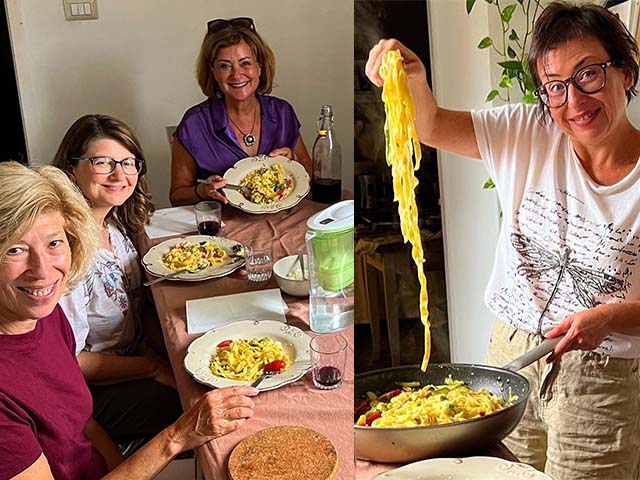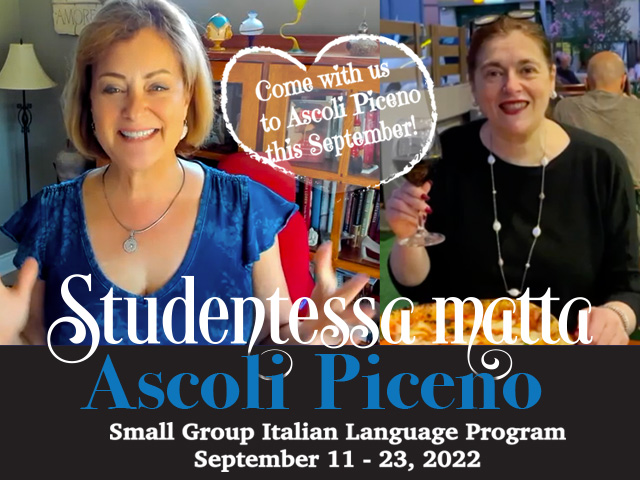
Lezione sui pronomi italiani diretti e indiretti – un ripasso
Anche se sono in Italia con il mio gruppo di studenti ad Ascoli Piceno, sto ancora lavorando con gli studenti negli Stati Uniti attraverso il “miracolo” di Zoom! Lavoro con una studentessa in particolare che frequenta un corso di italiano a università. L’altro giorno aveva qualche dubbio su pronomi diretti o indiretti. Così ho organizzato questa lezione per spiegare meglio il funzionamento dei pronomi italiani.
Although I am in Italy with my group of “studenti” in Ascoli Piceno, I am still working with students in the United States through the “miracle” of Zoom Calls! I work with a particular student who attends an Italian course at university. The other day she had some doubts about direct or indirect pronouns. So I organized this lesson to explain better how Italian pronouns work.
Indirect Object Pronouns are very similar to Direct Object Pronouns.
The difference lies in TWO main areas – the third person pronouns (lui/lei) and in how Direct Object Pronouns answer the questions “whom?” and / or “what?” while Indirect Object Pronouns answer the questions “to whom?” and/or “for whom?”
Il modo migliore per capire le differenze è rivedere molti esempi.
The best way to understand the differences is by reviewing lots of examples.

Iniziamo rivedendo i pronomi degli oggetti indiretti
Let’s get started by reviewing the Indirect object pronouns
INDIRECT OBJECT PRONOUNS
Indirect Object Pronouns take the preposition “a” (to).
Indirect Object Pronouns answer the questions “to whom?” and/or “for whom?”
Mi – a me (to me)
Ti – a te (to you)
Gli – a lui (to him)
Le – a lei (to her)
Ci – a noi (to us)
Vi – a voi (to you guys/you all)
Gli – a loro (to them)
Se hai già familiarità con come formare frasi usando “piacere” questi pronomi avranno già un aspetto familiare.
If you are already familiar with how to form sentences using “piacere” these pronouns will already look familiar.
A noi piace vino rosso. Ci piace vino rosso.
To us red wine is pleasing. We like red wine.

Quick review of “piacere” verb with indirect object pronouns.
“Piacere,” is the verb used to say “To like.” For English speakers ,we have to think in a reversed way. We have to think that “Something is pleasing TO ME” or that “TO ME something is pleasing.”
Questa stessa mentalità, è necessaria per capire come usare i pronomi dell’oggetto indiretto italiano.
This same mentality is necessary to understand how to use the pronouns of the Italian indirect object.
Adesso diamo un’occhiata a Direct Object Pronouns
DIRECT OBJECT PRONOUNS
Object Pronouns do not requre a preposition.
Object Pronouns answer the questions “whom?” and / or “what?”
Mi – me
Ti – you
Lo – him / it
La – her / it
Ci – us
Vi – you guys
Li – them (masc.)
Le – them (fem.)

Daniela fa la pasta. Daniela la fa.
Daniela makes the pasta. Daniela makes it.
Le ragazze mangiano il tiramasu. Le ragazze lo mangiano.
The girls eat the tiramasu. The girls eat it.
Un po’ di pratica con pronomi diretti e indiretti

Direct Pronouns:
Conosci Melissa, la matta?
Do you know Melissa, la studentessa matta?
Sì, LA conosco.
Yes, I know HER or Yes, IT IS HER that I know.
Conosci Francesco? Sì LO conosco.
Do you know Francesco? Yes, I know HIM.
Indirect Pronouns:
Puoi scrivere qualcosa a Melissa?
Can you write something to Melissa?
Sì, Le scrivo qualcosa.
Yes, I’ll write something TO HER or Yes, TO HER I’ll write something.
Puoi scrivere qualcosa a Francesco?
Can you write something to Francesco?
Sì, GLI scrivo qualcosa.
Yes, I’ll write something TO HIM or Yes, TO HIM I’ll write something.
Spiegazioni / Explanations
In the examples using the Direct Object Pronouns, we answered the question “WHO is it that you know?”
In the examples using the Indirect Object Pronouns, we answered the question “TO WHOM will you write something?”s
See the difference? That TO WHOM makes all the difference.
For the Indirect example, you could just do this:
Puoi scrivere qualcosa a Melissa?
Sì, scrivo qualcosa a Melissa.
But do you see how it’s repetitive? It sounds awkward and repetitive when you say it. That’s why these pronouns are so useful.
Altri esempi!
Here are a bunch of examples!
Mi puoi portare qualcosa da mangiare?
Can you bring me something to eat?
Sì, ti porto qualcosa subito!
Yes, I’ll bring you something right away!
This answers the question, TO WHOM will you bring something? TO YOU.
Ci dai più tempo, per favore?
Can you give us more time, please?
This answers the question, TO WHOM can you give more time? TO US.
Vi chiediamo scusa. We ask for your forgiveness.
This answers the question, TO WHOM are you asking forgiveness? TO YOU GUYS.
Lui vuole parlare con sua fidanzata?
Does he want to talk to his girlfriend?
No, non le vuole parlare.
No, he doesn’t want to talk to her.
This answers the question, WHO IS IT he wants to talk to? TO HER
If you ever find it too difficult to use an Indirect Object Pronoun, like in our last example, there are two other ways of wording that response:
“No, lui non le vuole parlare” – that way you reinforce that it is HE that doesn’t want to talk TO HER
“No, lui non vuole parlare con lei” – this is without using an indirect object pronoun
If you’re wondering whether you can attach Indirect Object Pronouns onto the end of a verb in its infinitive form, you can!
So we can write out the last example like this: “No, lui non vuole parlarle”

Ti giuro le cose diventano più facile con la pratica!
If you are feeling like you are wading into deep waters… just remember things get easier with practice!
And, I’m here to help you! If you would like to sign up for personal Italian language lessons, coachor conversationing, click here!
Rest assured that to get things like this you just need lots of practice. Try to brainstorm some sentences on your own and see how you do.
So this has been my lesson on Italian Indirect Object Pronouns!
Now that you know how to use both Indirect and Direct Object Pronouns, you can move on to Double Pronouns, which are lots of fun too! When you use them you sound like a true Italian speaker. Double Pronouns are when you use Indirect and Direct Object Pronouns in the same sentence.
Buckle your seat belt… or put on your life vest — a lesson on Double Pronouns will be coming soon!

Join me in 2023 for three NEW Matta Italian Language Immersion Programs!
To learn more & to sign up click on links below.










